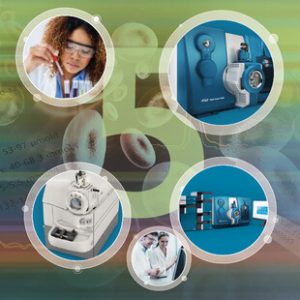 According to the American Clinical Laboratory Association, more than 7 billion clinical lab tests are performed in the U.S. every year. While mass spectrometry represents only a fraction of the clinical applications, there are a growing number of tests where mass spectrometry is becoming the analytical method of choice. This is particularly the case where accuracy is challenged by interference from other compounds, such as toxicology testing, therapeutic drug monitoring, and in the measurement of low-level endogenous steroids.
According to the American Clinical Laboratory Association, more than 7 billion clinical lab tests are performed in the U.S. every year. While mass spectrometry represents only a fraction of the clinical applications, there are a growing number of tests where mass spectrometry is becoming the analytical method of choice. This is particularly the case where accuracy is challenged by interference from other compounds, such as toxicology testing, therapeutic drug monitoring, and in the measurement of low-level endogenous steroids.
This trend shift is driven by the analytical specificity of mass spectrometry as well as the advancement of this technology along with the development of new applications. Liquid chromatography-tandem mass spectrometry (LC-MS/MS) is a particularly powerful, accurate, and robust technique for clinical diagnostics, especially for quantitative analysis of low concentration compounds. When comparing to conventional analytical techniques, the unique capabilities of mass spectrometry makes it is easy to see why mass spectrometry adoption is accelerating and beginning to play a prominent role in more areas of medicine.
As more labs make the move to mass spec, we look at the top five reasons why:
- Benefit from faster ROI: Experience significant savings and secure a faster return on investment from the lower operating costs offered by LC-MS/MS. You can bring send-outs in-house, improve turnaround times for results, and achieve lower cost per sample, not to mention improve test accuracy – giving your bottom line a boost.
- The right answer, the first time: The high sensitivity and high specificity of LC-MS/MS delivers more accurate data and greater confidence in results as compared to other laboratory methods. Many traditional analytical techniques simply cannot meet the same levels of performance in detecting trace levels (pg/mL) of analytes in complex matrices, with high accuracy and precision.
- Taking the preparation out of sample prep: With high-end sensitivity, sample prep doesn’t require derivatization and is generic, allowing simultaneous analysis across multiple compound classes. Assays are easily adaptable to new analytes. Due to the high selectivity of LC-MS/MS, baseline separation of analytes isn’t required, and over 100 compounds can be analyzed in 18 minutes.
- Boost efficiency with more data from a single injection: LC-MS/MS is highly sensitive with a large dynamic range that enables you to monitor multiple analytes from various types of matrices in a single run. This provides a broader panel of results in a single injection – giving you faster results and increased efficiency.
- Faster time to results: LC-MS/MS significantly reduces sample preparation and analytical run times. By bringing your tests in-house, you can improve turnaround times to give high-quality results in minutes, rather days or even weeks when sending out. You can simplify workflows with a robust technology that supports enhanced uptime and is rugged enough to support a high volume of clinical tests.

Clinical Mass Spec from SCIEX – Designed for Routine and Advanced Diagnostics
SCIEX In Vitro Diagnostic Medical Devices combine best-in-class mass spec instruments, intuitive software, and preconfigured methods*. Our solutions are fully backed by market leading service, support, and training to help guarantee your long-term success in adopting mass spec in your clinical lab. If you are:
- New to LC-MS/MS: The SCIEX 4500MD Mass Spectrometer is your medical device solution for best-in-class reliability, reproducibility, and performance for routine clinical testing. Read the brochure for more information >
- Ready for a faster, more sensitive LC-MS/MS: The Citrine™ System offers your clinical lab high-performance mass spectrometry by developing large multi-analyte panels.
Consider all the factors above, why is your lab waiting to save time, cut costs and support physicians with greater confidence and more accurate results? Learn More About How SCIEX Clinical Diagnostics Solutions Can Transform Your Clinical Lab >
SCIEX Diagnostics products are for in vitro diagnostic use. Product(s) may not be available in all countries. For information on availability, please contact your local representative. All other SCIEX products are for research use only. Not for use in diagnostic procedures.






 Contact Support
Contact Support
0 Comments